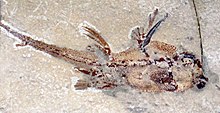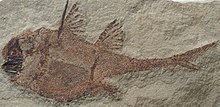| Echinochimaera Temporal range: Upper Mississippian, 318.1–328.3 Ma PreꞒ Ꞓ O S D C P T J K Pg N ↓ | |
|---|---|

| |
| Specimen of Echinochimaera meltoni | |

| |
| A diorama of Echinochimaera | |
| Scientific classification | |
| Kingdom: | Animalia |
| Phylum: | Chordata |
| Class: | Chondrichthyes |
| Subclass: | Holocephali |
| Order: | Chimaeriformes |
| Suborder: | Echinochimaeroidei |
| Family: | Echinochimaeridae |
| Genus: | Echinochimaera Lund, 1977 |
| Species | |
| |
Echinochimaera ("prickly chimera") is an extinct genus of chimaeriform fish, known from the Lower Carboniferous Bear Gulch Limestone in Montana, United States. It is one of the earliest Chimaeriformes known.
Taxonomy
The genus' name derives from the Greek εχινό (echino) meaning spiny, and chimaera. It is assigned to the order Chimaeriformes.
Species
The two known Echinochimaera species lived in the Upper Mississippian (Serpukhovian). Fossils of the species were found in the Bear Gulch Limestone in Montana, United States.
Both species have rounded bodies and paddle-like tails as well as large pectoral fins, two dorsal fins and a jaw fused to the braincase. The paddle-like tails indicate that E. meltoni was likely not a predator nor a fast swimmer.
Echinochimaera meltoni

E. meltoni was first described by Richard Lund, an Adelphi University palaeontologist, in 1977. The fossils found of E. meltoni have shown a great deal of sexual dimorphism, males being found to have a maximum 150mm body length while the maximum body length found in females was only 70mm (juveniles were 13-20mm). In general, the females only grew to about half the size of the males. Males also had four pairs of spikes which may have been used to defend against predators and to identify the fish as male.
There was a relative abundance of immature male fossils found, and that together with the significant sexual dimorphism indicate there was extreme sexual selection among the species.
Echinochimaera snyderi
E. snyderi was described, like E. meltoni, by Richard Lund. It was described in 1988 based on juvenile specimens, all with a body length under 90mm. E. snyderi differs from E. meltoni in fin detail as well as jaw shape and teeth near the front edge of the face rather than a tooth plate, in mature specimens later found its mature size was found to be larger than E. meltoni.
References
- ^ "The Paleobiology Database". Retrieved 2009-09-25.
- ^ "The Taxonomican: Genus Echinochimaera". Retrieved 2009-09-25.
- ^ "University of Montana Paleontology Center". 2007-11-01. Archived from the original on 2010-06-28. Retrieved 2009-09-26.
- "Search for Ancient Sharks". Discovery Education. Archived from the original on 2009-12-10. Retrieved 2009-10-11.
- ^ Lund, Richard (1990). "Chondrichthyan life history styles as revealed by the 320 million years old Mississippian of Montana". Environmental Biology of Fishes. 27 (1). Springer Netherlands: 1–19. doi:10.1007/BF00004900. ISSN 1573-5133.
- ^ "Fossil Fishes of Bear Gulch - Echinochimaera meltoni". 2006-02-01. Archived from the original on 2012-02-12. Retrieved 2015-12-09.
- "Bear Gulch - About Richard Lund". 2006-11-16. Archived from the original on 2010-01-08. Retrieved 2009-09-27.
- "Fossil Fishes of Bear Gulch - Echinochimaera snyderi". Archived from the original on 2010-07-29. Retrieved 2009-09-26.
| Taxon identifiers | |
|---|---|
| Echinochimaera | |